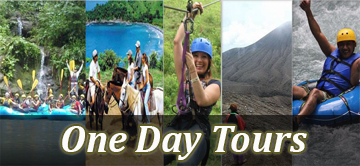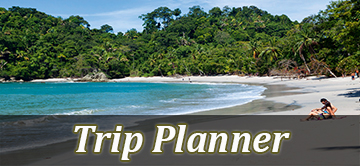Pre-Columbian period
There is archaeological evidence that indicates the arrival of the first humans to Costa Rica was between 10000 and 7000 B.C. In the Turrialba valley, recently discovered quarry areas and some installations for making tools support this claim. The settlers from this period were nomadic bands, about 20 to 30 hunters and other collective members. It is interesting to note, that some of the animals that were hunted then still exist today.
As such, with the arrival of these first inhabitants, the Meso-Americana cultures soon developed. The civilizations of the immediate area included the Costa Rican territory, the Eastern half of Nicaragua, Panama, Colombia and the Ecuadorian Pacific, all functioning like a bridge between the Meso-Americans cultures and the Andean Area. Technological interchange between both zones became possible; such as the development of metallurgy in Mexico and in Central America.
Costa Rica Periods
Colonial period
In 1502, the navigator Christopher Columbus, in his fourth and final expedition to the New World, anchors in the city of Limon, specifically in Uvita Island.
The European settlements begin in 1522. During this period, the natives of the country are conquered by the Spanish. Costa Rica in turn, becomes the southern province of the Spanish territory, now called the New Spain. The capital of the province at this time is located in Cartago. In 1513 Vasco Nuñez de Balboa discovers the Pacific Coast. Later the lake of Nicaragua is discovered by Gil Gonzalez Davila, around 1560. This territory continues to be explored by Juan de Cavallón and Juan Vázquez de Coronado. During the next three hundred years, Spain administers this region, as gold deposits are discovered by General Captain Post of Guatemala, a military governor. With optimism, the Spaniards refer the region as “Costa Rica” or “Rich Coast” for valued gold and mineral deposits therein. Ultimately, as these lands are not as richer as they were first believed to be, compared with other provinces, the settlers dedicate themselves primarily to agriculture.
Independence
In 1821, Costa Rica unifies the Central American provinces in the declaration of independence from Spain, on the 15th of September. For a brief period, 1823 – 1839, under the dominion of the Mexican Empire of Agustín de Iturbide, Costa Rica was part of the state in the United Provinces of Central America between. In 1824 the capital of the country was moved to San José, but it followed a period of rivalry with Cartago, the former capital.
Although all the recently independent Republics formed a Federation, regional borders disputes generated disagreements among them, adding to the regions unstable conditions. The northern province of Guanacaste was annexed freely to Costa Rica in 1824.
Under the command of Tomas Guardia Gutierrez (1870-1882), Costa Rica benefitted from great foreign investments in the railway routes and other public equipment. The arrival in the country of the United Fruit Company, allowed the development of the coastal plains in the Southern zone of the country, railway routes, as well as infrastructure. As a result of this development, the countries all though an independent state, become more dependent on international markets and the foreign capitals.
Years later, the country enjoyed an era of peace and democracy that began in 1889, when free elections were considered for the first time in the history of the country.
20th Century
Costa Rica Costa Rica has avoided as much as possible, the violence that has plagued Central America. Only two single periods of strong violence in the 20th Century, effected the democratic development. In 1917, Federico Tinoco Granados governed like a dictator for two years, after a coup.
In 1948 Jose Figueres Ferrer after victory in the civil war, abolished the army, and since then, Costa Rica has been one of the few countries in operating under the democratic system without the aid of an armed army.
The loss of 2000 soldiers in the 44 days of civil war was the bloodiest in the history of Costa Rica in the 20th Century, but the Assembly created a constitution that guaranteed free elections with universal suffrage and the abolishment of a standing army.
Figueres became a national hero, winning the first election under the new constitution in 1953. Since then, the country has successfully carried out twelve elections, the last election in 2006.
Costa Rica has reached a relatively high standard of living. At present, rapidly expanding industries in the area of technology in the form of electronic exports and tourism exceed agriculture as a source of revenue.
Costa Rica Today
With an approximate population of 5 million inhabitants and a territory of 51.100 Kilometers, Costa Rica is located in Central America, strategically located between North America and South America.
It has two important ports, one in the Pacific Ocean and the other Atlantic; 6 hours of distance between them. It has a constitutional set-up made up of three powers: Legislative, Executive and Judicial. Due to the country´s enormous wealth of flora and fauna and to the environmental awareness of the population, 25% of the national territory has been declared like protected areas.
Costa Rica TodayCosta Ricans are often referred to as “Ticos”, and are know mainly for their respect to the family union, continuous use of old customs and for overall friendliness and brotherhood.
Tico is a colloquial term for a native of Costa Rica. The plural form is Ticos. There are two explanations for the use of this word. One of the, is that Tico is used as a diminutive suffix instead of using ito. The second explanation of the word tico is that is it used to make little the word “Hermanitico” which is a friendly and a respectful way to refer to one another.
The Costa Ricans are very proud of their history; they continue reviving old customs, like cooking on a wood fired stove, drinking coffee every afternoon and going to church on Sundays, just to mention a few. The personal appearance of every person is always clean and polished.
A cordial greeting such as Buenos Dias (good morning) and Buenas Noches (good night) is the norm among Costa Ricans. Men will shake your hand and women will kiss your cheek as a way of saying hello or good bye. Costa Rica’s official religion is Catholicism, although the freedom to practice any religion exists. And woman are accepted nationally and equally to men in terms of employment opportunities.
In short, Costa Rica is a definite must among places to visit.
.













